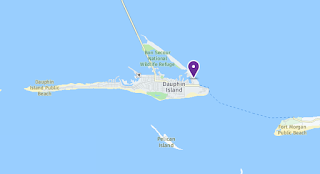 |
| Yahoo! Inc. map, 2017 |
The 14 mile long island contains a fort and an estuarium, along with housing, shops, restaurants, a light house, a bird sanctuary, plenty of beaches, and more. We were staying in Gulf Shores, on the map above you can see the edge of the land and Fort Morgan, so we drove the round-a-bout way to the tip of land and caught the car ferry. Along for the ride was my niece and her friend, none of us had been on a car ferry before so that is where the excitement began!
 |
| Ferry boarding rules: Load left to right; Lanes one thru four; Approximate load is 28 vehicles. |

While waiting for the ferry to arrive we watched lightning storm come across the bay. It was beautiful but we were told that if the storm was too fierce the ferry might be delayed. Lucky for us, it was not! The 30 minute ride across the opening of Mobile Bay was mostly filled with sites of oil and natural gas rigs, but it was still nice to be on the water.
Upon landing on the island we disembarked and headed toward the estuarium. Here is the definition as estuary from the National Ocean Service website:
"Estuaries and their surrounding wetlands are bodies of water usually found where rivers meet the sea. Estuaries are home to unique plant and animal communities that have adapted to brackish water—a mixture of fresh water draining from the land and salty seawater"
 |
| Petting the sting rays |
We were able to pet sting rays and horseshoe crabs along with learning more about the types of animals living in and around the estuary near Dauphin Island. My niece and her friend loved it (and they are teenagers!).
 |
| Turtles at the estuarium |
Afterwards, we took the half-block jaunt up the road to Fort Gaines.One of two forts built to protect Mobile Bay, construction began in 1819, but was not finished until 1853 and was used during the Civil War.
 |
| Central yard of the fort. |
In August 1864, after a fierce battle, the men of the fort surrendered to the Union. The fort stayed under Union control for the remainder of the war. Although the fort never came under fire again, it did play an important role through the Spanish American War through World War II.
 |
| Canon looking out towards Mobile Bay |
 |
| Standing atop the fort wall facing north |


No comments:
Post a Comment